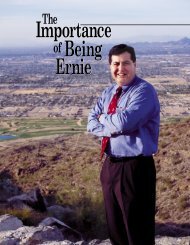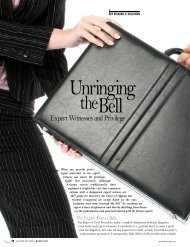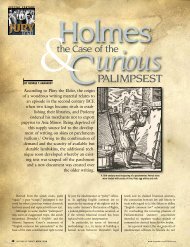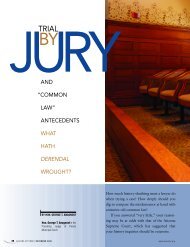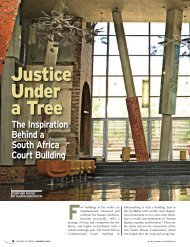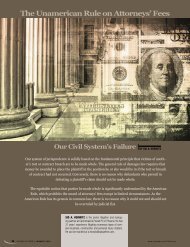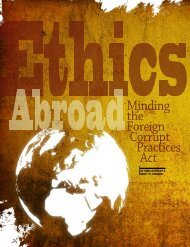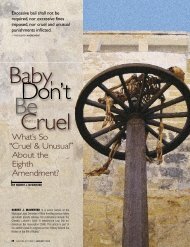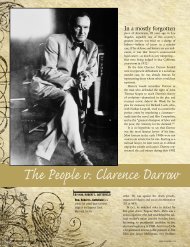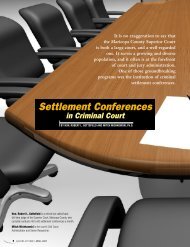Appellate Courts and Punitive Damage Calculations
Appellate Courts and Punitive Damage Calculations
Appellate Courts and Punitive Damage Calculations
- No tags were found...
You also want an ePaper? Increase the reach of your titles
YUMPU automatically turns print PDFs into web optimized ePapers that Google loves.
APPELLATE COURTS AND PUNITIVE DAMAGE CALCULATIONS<br />
Addressing the “Super-Jury” Problem<br />
the<br />
devil<br />
is in<br />
the<br />
details<br />
BY HOWARD ANDARI<br />
A recent case concluded with a punitive damage<br />
award that in today’s legal world is significant, but<br />
not extraordinary. The dispute between the parties—manufacturers<br />
of competing products—will not<br />
be historically noteworthy for its substance or for<br />
its players. But as in many significant cases, the<br />
devil is in the details. And the “devil” for counsel<br />
involved in punitive damage cases is the st<strong>and</strong>ard<br />
of review applied on appeal.<br />
The impact of Leatherman Tool Group v. Cooper<br />
Indus. will certainly be felt. Following Leatherman,<br />
appellate courts will not only be in the business of<br />
reviewing the constitutionality of punitive damage<br />
awards de novo. They also will calculate the “constitutionally<br />
appropriate” amount of punitive damages<br />
from the cold paper record—without the benefit<br />
of the live courtroom experience.<br />
At minimum, the case opens the door for state<br />
<strong>and</strong> federal appellate courts to act as “superjuries”<br />
<strong>and</strong> to calculate a “permissible” amount of<br />
punitive damages.<br />
Given Leatherman, it is vital that counsel make<br />
a clear <strong>and</strong> persuasive record at the trial court level<br />
in order to maximize the chances of preserving a<br />
punitive damage award on appeal.<br />
The Path of the Case<br />
In Leatherman, the Ninth Circuit Court of Appeals applied a de novo<br />
st<strong>and</strong>ard of review to the constitutionality of a $4.5 million punitive<br />
damage award. Using that st<strong>and</strong>ard, the Court concluded that the maximum<br />
award consistent with constitutional principles was exactly<br />
$500,000 1 (Leatherman II).<br />
The Ninth Circuit’s application of the de novo st<strong>and</strong>ard came after it<br />
was reversed by the U.S. Supreme Court 2 for upholding the $4.5 million<br />
award under the less-dem<strong>and</strong>ing “abuse of discretion” st<strong>and</strong>ard of<br />
review (Leatherman I). The circuit court previously had upheld the district<br />
court’s determination that the punitive damage award was constitutional<br />
<strong>and</strong> not “grossly excessive” under BMW of North America, Inc.<br />
v. Gore. 3<br />
Applying the more stringent st<strong>and</strong>ard of review on rem<strong>and</strong>, the<br />
Ninth Circuit not only decided that the punitive damage award was<br />
unconstitutional under Gore. It also took the extraordinary step of itself<br />
calculating the maximum award consistent with constitutional principles.<br />
The Ninth Circuit’s decision signaled the end of the case’s journey<br />
up <strong>and</strong> then down its appellate path. But questions for practitioners<br />
remain:<br />
• Did the decision in Leatherman I foreshadow this result<br />
• What steps should practitioners take to maximize their chances of<br />
preserving a punitive damage verdict on appeal in light of<br />
Leatherman II<br />
32 ARIZONA ATTORNEY JANUARY 2003 WWW.AZBAR.ORG
Leatherman I: The Tale of a Corporate Misdeed<br />
As described in Leatherman I <strong>and</strong> II, both<br />
Cooper Industries <strong>and</strong> Leatherman Tool<br />
Group were tool manufacturers. In the<br />
1980s, Leatherman introduced its Pocket<br />
Survival Tool (PST), a multifunction<br />
pocket tool that purported to be an<br />
improvement on the classic Swiss Army<br />
Knife. 4 In 1995, Cooper designed <strong>and</strong><br />
marketed a competing multifunction tool<br />
called the “ToolZall” that would copy the<br />
basic features of the PST <strong>and</strong> add a few<br />
additional features. 5<br />
In August 1996, Cooper introduced the<br />
ToolZall at the National Hardware Show in<br />
Chicago. There, Cooper used photographs<br />
in its posters, packaging <strong>and</strong> advertising<br />
materials that purported to be that of a<br />
ToolZall, but were in fact a modified PST.<br />
When Cooper’s promotional materials were<br />
created, Cooper had not yet manufactured<br />
a ToolZall <strong>and</strong> decided to create a ToolZall<br />
“mock-up” by grinding the Leatherman<br />
trademark off a PST <strong>and</strong> adding fasteners<br />
that were unique to the planned ToolZall. 6<br />
Shortly after the trade show, Leatherman<br />
filed suit against Cooper, asserting claims of<br />
trade-dress infringement, unfair competition<br />
<strong>and</strong> false advertising under § 43(a) of<br />
the Trademark Act of 1946 (Lanham Act)<br />
<strong>and</strong> a common-law claim for unfair competition<br />
for advertising <strong>and</strong> selling an “imitation”<br />
of the PST.<br />
After a 1997 trial, a jury found that<br />
Leatherman had trade-dress rights in the<br />
overall appearance of the PST <strong>and</strong> that the<br />
original ToolZall infringed on those rights,<br />
but that the infringement had not caused<br />
any damage to Leatherman. 7 With respect<br />
to the advertising claims, however, it found<br />
Cooper liable for passing off, false advertising<br />
<strong>and</strong> unfair competition; it assessed<br />
$50,000 in compensatory damages <strong>and</strong><br />
$4.5 million in punitive damages. 8<br />
After the jury verdict, the district court<br />
considered <strong>and</strong> rejected Cooper’s argument<br />
that the punitive damages assessed by<br />
the jury were unconstitutional <strong>and</strong> “grossly<br />
excessive” under Gore. 9 The court found<br />
that the punitive damages award “was proportional<br />
<strong>and</strong> fair, given the nature of the<br />
conduct, the evidence of intentional passing<br />
off, <strong>and</strong> the size of an award necessary<br />
to create deterrence to an entity of<br />
Cooper’s size” <strong>and</strong> concluded “that the<br />
award did not violate Copper’s due process<br />
rights” under the federal Constitution. 10<br />
On appeal, the Ninth Circuit affirmed<br />
the punitive damages award in an unpublished<br />
opinion, indicating, “The district<br />
court did not abuse its discretion in declining<br />
to reduce the amount of punitive damages.”<br />
11<br />
Scrutiny of the De Novo St<strong>and</strong>ard<br />
Thereafter, the U.S. Supreme Court accepted<br />
Cooper’s petition for a writ of certiorari.<br />
It addressed whether the Ninth Circuit<br />
reviewed the constitutionality of the punitive<br />
damage award under the correct st<strong>and</strong>ard<br />
<strong>and</strong> whether the award violated the<br />
Gore criteria.<br />
The Supreme Court concluded that the<br />
constitutionality of the punitive damages<br />
award merits de novo review, <strong>and</strong> it rem<strong>and</strong>ed<br />
the case to the Ninth Circuit for a determination<br />
of whether the $4.5 million award<br />
was constitutional using the correct st<strong>and</strong>ard<br />
of review. 12 The Supreme Court rejected<br />
an argument that de novo review violates<br />
the Seventh Amendment’s Reexamination<br />
Clause, which provides that “no fact tried<br />
by a jury shall be otherwise re-examined in<br />
any Court of the United States, than<br />
according to the rules of common law.” 13 In<br />
doing so, the Court indicated that “unlike<br />
the measure of actual damages suffered,<br />
which presents a question of historical or<br />
predictive fact, … the level of punitive damages<br />
is not really a ‘fact’ ‘tried’ by the<br />
jury.” 14<br />
It is this determination that may have<br />
encouraged, or possibly foreshadowed, the<br />
result in Leatherman II. 15<br />
Leatherman II: Calculating <strong>Punitive</strong><br />
<strong>Damage</strong>s<br />
In reviewing the constitutionality of the<br />
punitive damage award de novo, the Ninth<br />
Circuit applied the three “constitutional<br />
guideposts” from Gore. 16<br />
The Court concluded that the third Gore<br />
factor did not support the jury’s award<br />
because Cooper’s conduct would not have<br />
likely resulted in civil penalties in any<br />
amount approaching the $4.5 million punitive<br />
damage award. Regarding the second<br />
Gore factor, the Ninth Circuit observed that<br />
there is no mathematical bright line but<br />
indicated that the 90-to-1 ratio of compensatory<br />
to punitive damages was only somewhat<br />
less “breathtaking” than that invalidated<br />
in Gore, <strong>and</strong> it was impermissibly high<br />
given the evidence in the record with<br />
respect to the harm or potential harm<br />
caused by Cooper’s conduct.<br />
As to be expected, the Court focused<br />
most of its attention on the first Gore factor—reprehensibility.<br />
The Court acknowledged that in<br />
addressing reprehensibility, trial courts will<br />
have a somewhat superior vantage over<br />
“The level<br />
of punitive<br />
damages<br />
is not<br />
really a<br />
‘fact’‘tried’<br />
by the jury.”<br />
courts of appeal, <strong>and</strong> that it must accept the<br />
underlying facts as found by the jury <strong>and</strong><br />
the trial court. But the Court noted that the<br />
degree of reprehensibility “ultimately<br />
involves a legal conclusion.” 17 Although it<br />
could not “condone Cooper’s conduct,”<br />
the Court noted that after conducting an<br />
independent review, “Cooper’s conduct was<br />
more foolish than reprehensible.” 18 As a<br />
result, the Court concluded that the first<br />
Gore factor did not support the jury’s<br />
award.<br />
Despite this conclusion in light of a de<br />
novo review, the next question was of paramount<br />
procedural importance. The Court<br />
considered whether to:<br />
1. determine the maximum amount of<br />
constitutionally permissible damages or<br />
2. rem<strong>and</strong> the case to the district court<br />
with instructions to issue a remittitur in<br />
accordance with the views in its opinion<br />
On that question, there was no clear<br />
WWW.AZBAR.ORG<br />
JANUARY 2003 ARIZONA ATTORNEY<br />
33
authority (or briefing by the parties). In<br />
deciding to determine the maximum constitutional<br />
award of punitive damages on<br />
the existing record, the Ninth Circuit was<br />
influenced by Johansen v. Combustion<br />
Engineering, Inc. 19 According to the Court,<br />
it was not necessary to rem<strong>and</strong> for a new<br />
trial or rem<strong>and</strong> to the district court for<br />
remittitur, because a litigant would not be<br />
entitled to any greater award on rem<strong>and</strong><br />
than the maximum constitutional award of<br />
punitive damages. 20<br />
In determining the appropriate amount<br />
of punitive damages, the Ninth Circuit<br />
found itself in an uncomfortable <strong>and</strong> unfamiliar<br />
position. After quoting a passage<br />
from InterMedical Supplies v. EBI Medical<br />
Systems 21 that “in the last analysis, an appellate<br />
panel, convinced that it must reduce an<br />
award of punitive damages, must rely on its<br />
combined experience <strong>and</strong> judgment,” the<br />
endnotes<br />
1. Leatherman Tool Group v. Cooper Indus., 285<br />
F.3d 1146 (2002).<br />
2.Cooper Indus. v. Leatherman Tool Group, 532<br />
U.S. 424 (2001).<br />
3.517 U.S. 559 (1996).<br />
4.Leatherman I, 532 U.S. at 427.<br />
5.Id. Although the Cooper product was named<br />
ToolZall, internally it had been referred to as<br />
the “Cooperman” because of its obvious similarity<br />
to Leatherman’s PST. Leatherman II,<br />
285 F.3d at 1148.<br />
6.Leatherman I, 532 U.S. at 427-428.<br />
7.Id. at 429. As a result of this finding, however,<br />
the district court entered a judgment permanently<br />
enjoining Cooper from marketing<br />
its original ToolZall in the United States or in<br />
22 designated foreign counties. That judgment<br />
was later set aside by the Ninth Circuit.<br />
199 F.3d 1009 (9th Cir. 1999).<br />
8.Id. In awarding punitive damages, the jury<br />
answered the following special interrogatory<br />
in the affirmative: “Has Leatherman shown by<br />
clear <strong>and</strong> convincing evidence that by engaging<br />
in false advertising or passing off, Cooper<br />
acted with malice, or showed a reckless <strong>and</strong><br />
outrageous indifference to a highly unreasonable<br />
risk of harm <strong>and</strong> as acted with a conscious<br />
indifference to Leatherman’s rights”<br />
9.517 U.S. at 559.<br />
10.Leatherman I, 532 U.S. at 430.<br />
11.Id.<br />
12.The Supreme Court reiterated that in Gore,<br />
appellate courts were instructed to evaluate a<br />
punitive damages award’s consistency with<br />
due process using three criteria: (1) the<br />
degree of reprehensibility of the defendant’s<br />
misconduct (“reprehensibility”), (2) the disparity<br />
between the harm suffered <strong>and</strong> the<br />
punitive damages award (“ratio”) <strong>and</strong> (3) the<br />
difference between the punitive damages<br />
awarded by the jury <strong>and</strong> the civil penalties<br />
authorized or imposed in comparable cases<br />
(“comparable statutory fines”). Id. at 440.<br />
The Court then conceded with respect to<br />
“reprehensibility,” trial courts “have a somewhat<br />
superior vantage over courts of appeal”<br />
with respect to issues turning on “witness<br />
credibility <strong>and</strong> demeanor.” Id. However, the<br />
Court noted that trial <strong>and</strong> appellate courts<br />
seem equally capable of analyzing the second<br />
inquiry, <strong>and</strong> that the third inquiry, which<br />
“calls for a broad legal comparison, seems<br />
more suited to the expertise of appellate<br />
courts.” From this st<strong>and</strong>point, the Court concluded<br />
that “[c]onsiderations of institutional<br />
competence therefore fail to tip the balance in<br />
favor of deferential appellate review.” Id.<br />
13.Id. at 437–438. Traditionally, federal courts<br />
did not have any authority to reduce the<br />
amount of a jury’s verdict. Kennon v. Gilmer,<br />
131 U.S. 29 (1889). However, federal courts<br />
did traditionally have the power to order a<br />
new trial (e.g., when courts found a jury’s<br />
award of damages to be excessive). The power<br />
of courts to order a remittitur grew out of the<br />
authority to grant a new trial. Therefore,<br />
when trial courts believe the jury’s verdict is<br />
excessive, they may order a new trial unless<br />
the plaintiff agrees to remit a portion of the<br />
jury’s award. Dimick v. Sciedt, 293 U.S. 474,<br />
(1935). However, the Seventh Amendment<br />
requires that the plaintiff be provided the<br />
option of a new trial in lieu of a remittitur of<br />
the jury’s award. Hetzel v. Prince William<br />
County, Va., 523 U.S. 208, (1998).<br />
14.Leatherman I, 532 U.S. at 437.<br />
15.Justice Ginsberg’s lone dissent critiqued the<br />
majority’s holding that the amount of punitive<br />
damages is not a “fact tried by a jury.” Id. at<br />
446. And she argued that the “abuse of discretion”<br />
st<strong>and</strong>ard of review makes sense for<br />
“practical reasons”: “District courts view the<br />
evidence not on a cold paper record but in<br />
the living courtroom context.” Id. at 448.<br />
Therefore, with respect to Gore’s reprehensibility<br />
factor, “District courts have an undeniably<br />
superior vantage over courts of appeal.”<br />
Id.<br />
16.Leatherman II, 285 F.3d at 1148–1150.<br />
17.Id. at 1150.<br />
18.Id. at 1151.<br />
19.170 F.3d 1320 (11th Cir 1999). In Johansen,<br />
the Eleventh Circuit considered whether it<br />
was permissible for the district court to reduce<br />
the jury’s punitive damage verdict to a maximum<br />
constitutional amount without affording<br />
the plaintiffs an opportunity to elect for a new<br />
trial. Johansen distinguished the district<br />
court’s action from a traditional remittitur<br />
because unlike a remittitur, a constitutional<br />
reduction is a determination that the law does<br />
not permit the award. Id. at 1331. As such, it<br />
was permissible for the district court to enter<br />
judgment for the maximum constitutionally<br />
permissible award as a matter of law, without<br />
giving the plaintiffs an opportunity for a new<br />
trial. Id. According to Johansen, adjusting the<br />
punitive damage verdict to the maximum the<br />
Constitution allows is not a reexamination of<br />
any facts, but if the district court exercised its<br />
discretion to reduce the verdict lower than the<br />
constitutional maximum for that case, the verdict<br />
would then have been “reexamined” <strong>and</strong><br />
the plaintiff must be afforded the option to<br />
elect a new trial. Id. at 1332, n.20.<br />
20.Leatherman II, 285 F.3d at 1151–1152.<br />
Johansen ultimately upheld the district court’s<br />
determination of the maximum constitutional<br />
award after consideration of the Gore factors.<br />
170 F.3d at 1339. However, Johansen did<br />
note that, “It is unclear to us whether BMW<br />
allows an appellate court to determine the<br />
‘upper limit’ the constitution permits, or<br />
requires rem<strong>and</strong> to the district court where<br />
the record is not so ‘cold.’” Id. at 1332, n.21.<br />
The Ninth Circuit, however, did not appear to<br />
be tempted to rem<strong>and</strong> because requiring a<br />
new trial or remittitur by the lower court<br />
could ultimately result in an appeal, which<br />
would then require another evaluation of<br />
whether the punitive damage award was constitutional<br />
under a de novo st<strong>and</strong>ard.<br />
21.181 F.3d 446, 468 (3rd Cir. 1999).<br />
22.Leatherman II, 285 F.3d at 1152. The Third<br />
Circuit in InterMedical Supplies reduced a<br />
remitted $50 million punitive damage award<br />
to $1 million after consideration of the Gore<br />
factors. 181 F.3d at 470. The dissent criticized<br />
the majority because it “substituted its<br />
personal judgment for a principled review<br />
function over a District Court’s discretion;<br />
<strong>and</strong> without relying on record evidence, it has<br />
reached a bottom line ‘lottery’ figure of<br />
$1,000,000 relying only on its own ‘judgment<br />
<strong>and</strong> experience.’” Id. at 478.<br />
23.See e.g., Hyatt Regency v. Winston & Strawn,<br />
907 P.2d 506 (Ariz. Ct. App. 1995).<br />
24.See F.R.C.P. 49; A.R.C.P 49. It is important<br />
to consider the complexity of the case to<br />
determine whether the benefits of special verdict<br />
forms, or a general verdict with written<br />
interrogatories, outweigh the potential for<br />
confusion of the jury <strong>and</strong> inconsistent jury<br />
verdicts or answers to interrogatories.<br />
25.See Leatherman I, 532 U.S. at 440, n.14<br />
(“While we have determined that the Court of<br />
Appeals must review the District Court’s<br />
application of the Gore test de novo, it of<br />
course remains true that <strong>Courts</strong> of Appeal<br />
should defer to the District Court’s findings<br />
of fact unless they are clearly erroneous.”);<br />
Leatherman II, 285 F.3d at 1150 (“Although<br />
determining the ‘degree of reprehensibility’<br />
ultimately involves a legal conclusion, we must<br />
accept the underlying facts as found by the<br />
jury <strong>and</strong> the district court.”).<br />
34 ARIZONA ATTORNEY JANUARY 2003 WWW.AZBAR.ORG
Ninth Circuit concluded that exactly<br />
$500,000 was the maximum constitutional<br />
award of punitive damages on the existing<br />
record. 22<br />
The Implications of Leatherman II<br />
Leatherman II’s implications are not limited<br />
to the federal court system. Arizona’s<br />
appellate courts have made clear that any<br />
award of punitive damages must pass<br />
scrutiny under the federal Constitution. 23<br />
Because the Due Process Clause of the<br />
Fourteenth Amendment prohibits states<br />
from imposing “grossly excessive” punishments<br />
on tortfeasors under Gore, it follows<br />
that Arizona appellate courts will have to<br />
apply a de novo review of the constitutionality<br />
of a punitive damage award using the<br />
Gore criteria.<br />
Given Leatherman II, appellate courts<br />
in Arizona may now act as super-juries <strong>and</strong><br />
themselves calculate “constitutionally<br />
appropriate” punitive damages.<br />
To somewhat mitigate the dangers<br />
posed by Leatherman II, practitioners may<br />
want to have juries make specific factual<br />
findings on the issue of reprehensibility<br />
through special verdict forms or a general<br />
verdict accompanied by written interrogatories.<br />
24 In addition, practitioners also<br />
should urge the trial court to make specific<br />
findings of fact regarding reprehensibility<br />
in post-trial rulings on the constitutionality<br />
of the punitive damage award. In doing so,<br />
the language from Leatherman I <strong>and</strong> II<br />
regarding deference to findings of fact by<br />
the trial court <strong>and</strong> jury may prove to be<br />
helpful in preserving <strong>and</strong>/or maximizing<br />
punitive damage awards. 25<br />
Given that appellate courts may now<br />
more often calculate punitive damage<br />
amounts from the cold paper record, making<br />
a coherent <strong>and</strong> persuasive record on<br />
issues surrounding reprehensibility<br />
becomes more important than ever.<br />
Howard Andari is an attorney in the<br />
Scottsdale law firm of Thur & O’Sullivan,<br />
P.C., practicing exclusively for the last six<br />
years in the fields of insurance coverage <strong>and</strong><br />
insurance bad faith. The statements or opinions<br />
expressed herein are those of the author<br />
<strong>and</strong> do not necessarily reflect those of his firm,<br />
its directors, partners or employees.<br />
WWW.AZBAR.ORG<br />
JANUARY 2003 ARIZONA ATTORNEY<br />
35



